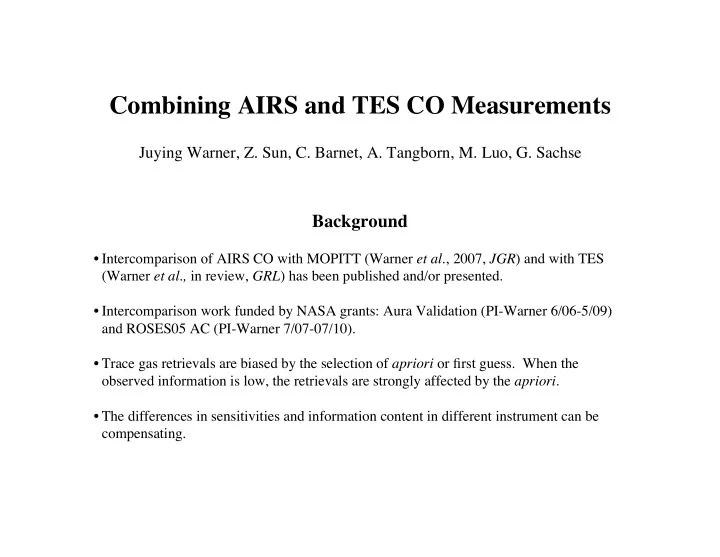

Combining AIRS and TES CO Measurements Juying Warner, Z. Sun, C. Barnet, A. Tangborn, M. Luo, G. Sachse Background • Intercomparison of AIRS CO with MOPITT (Warner et al ., 2007, JGR ) and with TES (Warner et al., in review, GRL ) has been published and/or presented. • Intercomparison work funded by NASA grants: Aura Validation (PI-Warner 6/06-5/09) and ROSES05 AC (PI-Warner 7/07-07/10). • Trace gas retrievals are biased by the selection of apriori or first guess. When the observed information is low, the retrievals are strongly affected by the apriori . • The differences in sensitivities and information content in different instrument can be compensating.
Mar. 04, 2006 + INTEX-B DC-8 Track TES Overpass AIRS maps • AIRS and TES, on A-train, take CO and O 3 measurements within 15min of each other. AIRS coverage is higher due to wide swaths and cloud clearing. TES provide higher sensitivity and more information in the lower troposphere due to its higher spectral resolution. • Under nadir AIRS and TES are collocated TES L2 profiles are used as apriori in AIRS retrievals. • TES profiles are populated to AIRS space where they are not collocated using Objective Analysis method to produce a post-processed apriori field. • Re-process AIRS retrieval using the new apriori field.
• Using TES L2 profiles in AIRS DACOM retrievals increase lower tropospheric On DC-8 information compared with using AIRS alone, which is especially important for air quality monitoring. TES • This increased information in the lower troposphere, as shown in the right bottom panel compared with the 3rd panel, will be populated onto AIRS coverage. AIRS • Higher CO in the lower troposphere is due to the fire activities over the south-east US. AIRS + • AIRS v5 CO may contain more TES lower trop info than display here, using TES should still improve retrievals nonetheless.
• Combined AIRS and TES CO agree better with in situ throughout troposphere. • Below 900mb, sensitivities for both sensors decrease significantly.
Data Assimilation Algorithm (for each pressure level) • AIRS Data Set (background): x b • TES Data Set (observation): y • Gain matrix: K • Background Error Covariance (synthetic): P b • Observation Error Covariance (synthetic): R • Observational Operator: H • Analysis State (assimilation output / apriori input): a b b x x K ( y Hx ) = + � b T b T 1 K P H ( HP H R ) � = +
• TES lower troposphere information is propagated using AIRS variance. • Full “assimilation” scheme with proper retrieval error covariances is needed to develop the post-processed apriori . • The combined CO shows better agreement with TES and DACOM.
Summary and Future Work • Combining AIRS and TES increases lower tropospheric CO information compared with AIRS, and • increases coverage compared with TES. • Future work involves increased accuracy of the post-processed apriori field by including proper error covariance matrices from the satellite retrievals. • Including other datasets such as MLS CO, etc. • Testing this technique on AIRS optimal estimation retrievals, which is funded and under development.
Recommend
More recommend